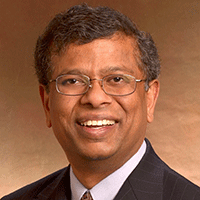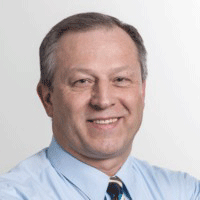Wednesday, October 19, 2022
10:30 AM – 12:30 PM
Dr. Vladimir Navrotsky, Vice President Technology & Innovation, Siemens Energy Service and Professor Babu Sudarshan, ORNL Governor’s Chair of Advanced Manufacturing and Director of Bredesen Center for Interdisciplinary Research & Graduate Education at the University of Tennessee, Knoxville have joined forces to deliver a keynote program addressing the need to accelerate the industrialization of additive manufacturing in strategic next generation products.
Navrotsky & Sudarsanam highlight the imperative role of innovative developments from coupon to part level qualifications in a scientific manner using concurrent and integrated approaches between experiments developing predictive capabilities including advanced inspection technologies.

Professor Babu Sudarshan
ORNL & University of Tennessee, Knoxville
Part Specific Qualification of Additively Manufactured Metallic Components
Dr. Babu obtained his bachelor's degree in metallurgical engineering from PSG College of Technology, Coimbatore, India, and his master's degree in industrial welding metallurgy-materials joining from Indian Institute of Technology, Madras. He obtained his PhD in materials science and metallurgy from University of Cambridge, UK in 1992. He also worked as a research associate in the prestigious Institute for Materials Research, Sendai, Japan before joining ORNL in 1993. From 1993 to 1997, he held joint researcher position with ORNL, University of Tennessee and The Penn State University. From 1997 to 2005, he worked as an R&D staff at ORNL. From 2005 to 2007, Suresh held a senior level technology leader position in the area of engineering and materials at Edison Welding Institute, Columbus, Ohio. From 2007 to 2013, Suresh served as Professor of Materials Science and Engineering and Director of NSF I/UCRC Center for Materials Joining Science for Energy Applications, at The Ohio State University. In 2013, Suresh was appointed as UT/ORNL Governor’s chair of advanced manufacturing at the University of Tennessee, Knoxville, TN. In this role he acts as a bridge to the ORNL's expertise and infrastructure including manufacturing demonstration facility to develop a collaborative research and education ecosystem locally and deploy engineering solutions to manufacturing industries. In 2019, Suresh was also appointed as Director of Bredesen Center for Interdisciplinary Research and Education for Energy- and Data- Science and Engineering. In 2020, Sures was selected to be the founding educational director of the UT-Oak Ridge Innovation Institute. In 2020, Suresh was appointed to the National Science Board by the President of the United States of America for a six-year term. In 2022, Suresh was appointed as inaugural position of senior advisor for research and STEM to the Provost and Vice Chancellor of Research.
Dr. Babu has 30 years of experience in the area of advanced manufacturing, additive manufacturing, physical metallurgy, as well as computational materials modeling. His work relates to welding metallurgy, solid-state joining, ultrasonic additive manufacturing, laser/electron beam assisted additive manufacturing, phase transformation issues related to low-alloy steels, inclusion formation, nonequilibrium solidification, and application of computational thermodynamics and kinetics to corrosion issues. He is also involved in the application of state-of-the-art characterization tools including atom probe tomography; synchrotron diffraction and neutron diffraction for understanding interaction between weld thermal cycles, phase stability and diffusion in complex alloys, as well as, energy storage materials. Dr. Babu has published more than 250+ journal papers and numerous conference proceedings. He has received many awards in recognition of his technical and leadership service to the materials and manufacturing community. He is a fellow of AAAS, ASM International and AWS.
In the last seven years, Suresh has been instrumental and part of the team in securing UTK and ORNL's leadership in NSF and Presidential initiatives related to national network of manufacturing innovation institutes. With his ability to foster collaborative activities with ORNL associates and UTK faculty, UTK has secured the following projects: NSF/IUCRC center for materials and manufacturing, Powder processing pillar of lightweight innovation for future (LIFT), Institute for Advanced Composites Manufacturing Innovation Institute (IACMI), Advanced Functional Fabrics of America (AFFOA), and Clean Energy Smart Manufacturing Innovation Institute (CESMII). Suresh is currently leading a ONR’s Multidisciplinary university research initiatives (MURI) program on fundamentals of additive manufacturing.
Keynote Title: Part Specific Qualification of Additively Manufactured Metallic Components
S. S. Babu1,2, M. M. Kirka2, A. Plotkowski3, P. Nandwana3, V. Paquit2 and R. R. Dehoff3 1Department of Mechanical, Aerospace, and Biomedical Engineering, The University of Tennessee, Knoxville, TN 37996; 2Manufacturing Sciences Division, 3Materials Science and Technology Division, Oak Ridge National Laboratory, Oak Ridge, TN 37831
Abstract: In the last decade, additive manufacturing (AM) has become a viable pathway for making metallic components for aerospace and energy applications. Although the feasibility of AM to make complex geometric components has been demonstrated, the ability to qualify these components for critical applications remains elusive. This challenge is related to spatial and temporal variations of thermal, mechanical, and chemical signatures within a single component that are quite different from traditional manufacturing. As a result, coupon-based qualification of AM parts may not be applicable in all cases. In this talk, an overview of the existing qualification methods that are based on extensive testing, as well as emerging techniques that are based on in-situ monitoring, computational modeling, machine learning and artificial intelligence will be presented. The application of these tools will be demonstrated with case studies of qualifying metallic components produced by AM for energy and aerospace applications. The case studies will span various powder bed fusion and directed energy deposition processes for titanium, nickel, and stainless steels. In addition, efforts to transfer these hardware and software technologies to industries will also be discussed. Finally, the future directions of AM to arrive at site-specific properties within components will be highlighted.

Dr. Vladimir Navrotsky
Vice President Technology & Innovation, Siemens Energy Service
Innovative developments in Additive Manufacturing and the industrialization of AM
Dr. Vladimir Navrotsky is a Senior principal Key Expert in gas turbine design and aftermarket.
He is a mechanical engineer and graduated from Moscow Physical & Technical University in 1983. He took his scientific degree from the same University in 1987. He gained his more than 35-year professional experiences in international organisations such as Central Institute of Aviation motors in Russia, ABB in Sweden, ALSTOM in Switzerland and Siemens.
As an employee of Siemens Energy for 25+ years, he has held several management positions. In 2015 Dr. Navrotsky awarded Siemens Top Innovator. In 2021 Dr. Navrotsky got a Global Power & Propulsion Society (GPPS) Innovation Award for his innovation contribution to global power and propulsion industry.
Keynote Title: Innovative developments in Additive Manufacturing and the industrialization of AM
Abstract: Additive Manufacturing is a disruptive technology enabling significant impact on Gas Turbine (GT), their performance, emissions, operation flexibility and lifecycle cost.
AM technology provides great opportunities in speeding up the time to market for new products and quick upgrades of the currently installed GT fleets.
The status and achieved results at Siemens Energy (SE) in AM technology development and implementation (e.g. AM workshops setup, components design, manufacturing, validation and serial production) will be presented and discussed in this presentation.
To support and enable emission reduction of the gas turbines SE has developed hydrogen capable AM burners. As a result, the SGT-600, -700 and -800 can today be offered to run on up to 75 vol-% H2 in the fuel.
Utilization of AM technology for design and manufacturing of new advanced cooling system for GT’s blades and vanes resulted in significant savings of the cooling airs and subsequently substantial engine efficiency improvements. Another measure enabling GT efficiency enhancement is aerodynamic efficiency improvement of blades and vanes due to practically unlimited AM capability. Successful design, manufacturing and validation of SGT-700 turbine AM vanes will be discussed in this presentation as well.